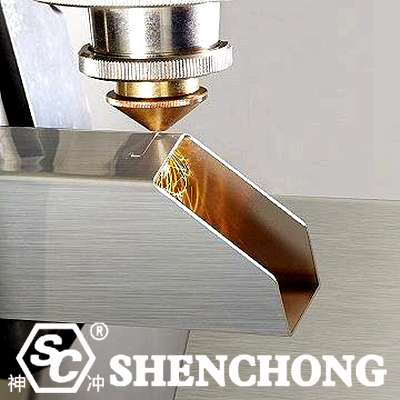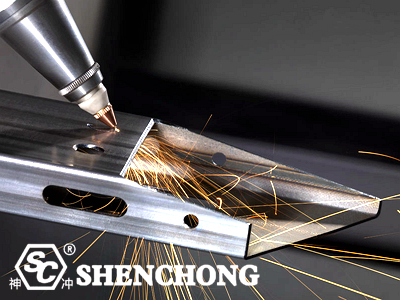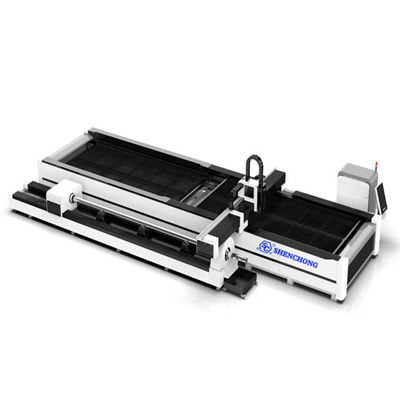
Improving laser tube cutting efficiency involves optimizing various aspects of the laser cutting process, including machine setup, material handling, cutting parameters, and post-processing. By focusing on these areas, you can maximize throughput, reduce costs, and ensure higher precision and quality in your cuts.

In addition to laser cutting, traditional cutting methods for tube processing include manual cutting, roller extrusion, saw cutting, grinding wheel cutting, gas welding cutting, etc. However, compared with these methods, laser cutting has significant advantages in processing quality and efficiency, saving manpower, and reducing burrs.
The laser tube cutting machine is controlled by a CNC system, the tube movement as the X-axis, the tube rotation as the A/B axis, the horizontal movement of the cutting head as the Y-axis, and the cutting head as the Z-axis. When the processing requirements change, we only need to adjust the programming. If it is equipped with an automatic loading and unloading system, the complex processing process can be completed in one step.
The advantages of using laser to cut pipes are: first, the thermal effect of cutting edges is very small, the workpiece will hardly be deformed; second, it is a non-contact processing method, which will not exert pressure on the workpiece, and will not cause deformation or wear problems; third, the laser beam is controllable, with higher adaptability and flexibility; fourth, the cutting efficiency can be increased by 8 to 20 times, while saving 15% to 30% of material loss.
CO2 laser and fiber laser are the two most common lasers in the cutting field. The working principle of CO2 laser is that CO2 gas is excited under high frequency and high pressure to generate laser, which is reflected and focused after passing through the polarizer in the resonant cavity for cutting.
Except for copper materials, which reflect all the laser light back to the laser due to its high reflectivity, CO2 lasers can cut most metal materials, as well as semiconductors, non-metallic materials, etc. However, this technology is limited by the distance range of the reflector, and the reflector needs to be maintained and calibrated. Due to the gas purity of CO2, the resonant cavity also needs to be cleaned regularly. For a large power CO2 cuttting system, these tasks cost at least $20,000 per year. In this case, fiber lasers come in handy.
The laser source of fiber laser is a multimode pump diode, which is coupled into a single optical fiber to form laser after being adjusted in the resonant cavity through branching.
Compared with CO2 laser, fiber laser cutting machine has no range limitation, can process copper materials, has lower maintenance cost, and most importantly, can greatly improve cutting speed while achieving photoelectric conversion efficiency of more than 25% (generally, the photoelectric conversion efficiency of CO2 laser is about 10%).
The limitation of fiber laser is that it can hardly cut non-metallic materials. In addition, the perforation time of fiber laser is longer than that of CO2 laser, so it has no advantage in cutting thicker materials. Although fiber laser has developed rapidly in recent years, it still cannot completely replace CO2 laser technology.
Click here to know more about: Fiber Laser Cutting Machine VS CO₂ Laser Cutting Machine | Which Is Better?
Of course not. When cutting pipes, especially small diameter square pipes, slag will adhere to the inner wall of the pipe, and most of the heat generated will be absorbed by the workpiece. If the cutting density is high, the pipe may overheat and burn, affecting the quality of the cut. In addition, the complex thermal field of the cutting seam, the difficulty of cooling, and the easy blockage of the cutting slag are also issues that need to be studied in depth.

As for the popular product laser tube cutting machine in the field of tube processing, this technology was still in the hands of foreign companies more than a decade ago. China efficient and professional laser tube cutting equipment only started to grow formally after 2008, but the development speed is very impressive.
At present, the research and improvement focuses on laser tube cutting machines include the following points:
In practical applications, pipes often have different wall thicknesses and cross-sectional shapes, which place high demands on the clamping effect of the equipment fixture. If the clamping force is too small, the pipe will move and produce processing deviations; if the clamping force is too large, the pipe will deform. The current laser pipe cutting machine can already adjust the clamping force quickly and adaptively according to the wall thickness of the material when processing standard pipes. There is also a technology that uses sensor monitoring to enable the self-centering chuck to adapt to any pipe geometry.
During high-speed cutting, the tube will sag due to its own weight. Due to the change in the curvature of the tube at the roller that fixes the chuck, the theoretical length of the workpiece will also change, affecting the accuracy of subsequent bending or hole processing steps. Therefore, it is necessary to strengthen the support of the tube. The servo mechanism can control the movement of the support surface or the roller that automatically adjusts the position to achieve effective fitting between the tube and the support surface.
Although most laser tube cutting machines have realized automatic loading and unloading, they still have problems such as low efficiency and easy scratches on the tube surface. Taking the Han's Laser P6018D as an example, to address these problems, it adopts a nylon surface sliding loading method, limited push branch pipe, and floating support unloading system, and embeds the small rotating shaft in the support plate to reduce scratches between workpieces.

Improving the laser tube cutting efficiency can significantly reduce production costs, shorten processing cycles, and improve the quality of finished products. The following is a detailed analysis of how to improve the efficiency of laser tube cutting from four aspects: equipment selection, process optimization, material preparation, and auxiliary systems.
Features: High-power lasers (such as 3000W and above) can cut thick pipes faster and reduce cutting time.
Advantages: Increase cutting speed while maintaining a smooth cutting edge.
Maintain the laser generator regularly to ensure stable output power.
Use reliable fiber lasers because of their high efficiency, low energy consumption and low failure rate.
Choosing a laser tube cutting machine that supports multi-axis linkage can complete complex curve and special-shaped cutting in one clamping, reducing clamping time.
Using equipment with automatic focusing function can quickly adapt to pipes of different thicknesses or materials, avoiding the time wasted due to manual focusing.
Equipped with automatic loading and unloading system to reduce manual operation time.
With intelligent programming function, it can realize automatic layout and optimized path.
Laser power: Select the appropriate power according to the thickness and material of the pipe. Too low power will reduce the cutting speed, and too high power may produce a heat-affected zone.
Cutting speed: Try to increase the speed while ensuring the cutting quality.
Auxiliary gas pressure: Selecting the appropriate auxiliary gas (oxygen, nitrogen, air, etc.) and pressure for different materials will help improve the cutting speed and accuracy.
Use intelligent cutting software to reduce the empty path (the part not cut when the laser head moves) and maximize the effective working time of the equipment.
Choose the appropriate laser cutting head and lens to avoid downtime caused by frequent replacement of accessories.
For thin-walled pipes, reduce cutting heat input to avoid material deformation and increase the defective rate.
In some special scenarios, drilling, tapping and other processes can be completed simultaneously with laser cutting to reduce secondary processing time.
Use pipes with standardized length, thickness and material to reduce the debugging time of the laser cutting machine.
Remove the oxide layer, oil stain or coating on the surface of the pipe to improve the cutting quality and speed.
Use quick clamps or automatic clamping systems to reduce the time of manual clamping adjustment.
Ensure clamping stability to avoid affecting cutting accuracy due to workpiece movement.
Oxygen: suitable for carbon steel cutting, accelerates oxidation reaction and increases cutting speed.
Nitrogen: suitable for stainless steel and aluminum cutting, avoids oxidation and improves finish.
Air: low cost, can be used for cutting scenes with lower requirements.
The layout software optimizes the cutting utilization of pipes, reduces material waste and improves cutting efficiency.
Ensure that the cooling system of the laser cutting machine works properly to avoid the equipment from reducing efficiency due to overheating.
Automatic waste recycling device is installed to reduce manual cleaning time and keep the working environment clean.
Improve the operator's operation level of laser cutting equipment, including programming, parameter adjustment and equipment maintenance skills.
Be familiar with the cutting characteristics of different materials and thicknesses, and optimize the cutting process.
Regularly check key components such as optical lenses, motors, and transmission systems to avoid downtime due to failures.
Regularly clean the guide rails and lead screws to ensure the smoothness and accuracy of the cutting head movement.
Reasonably arrange production plans to avoid long-term idleness or overload of equipment.
According to order requirements, prioritize large-volume and consistent cutting tasks to improve efficiency.
Use MES (manufacturing execution system) or IoT (Internet of Things) technology to monitor the operating status of the cutting machine in real time and deal with problems in a timely manner.
Data analysis
Record key data such as cutting time, material utilization, energy consumption, etc. to optimize the process.
Continuously upgrade cutting software, use AI to optimize path planning, and reduce processing time.
In short, tube laser cutting will develop towards high precision, high automation, flexibility and diversified functions in the future. Continuous practice and improvement of its process system have important research significance and value for the development of the entire laser cutting industry.
Improving the efficiency of a laser tube cutting process is not just about one change but optimizing a variety of factors such as machine settings, materials, tooling, automation, and workflow. Regular maintenance, the right choice of equipment, and advanced software tools play a critical role in improving throughput, reducing costs, and maintaining high-quality cuts. By systematically addressing these areas, you can achieve significant improvements in laser tube cutting efficiency and overall productivity.